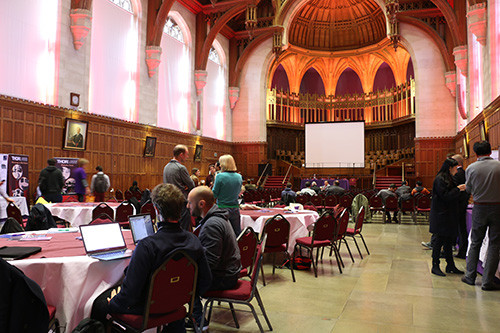
Quantum temple: will the congregation at Bristol’s Wills Memorial Building convert to quantum annealing?
By Hamish Johnston at the BQIT:16 conference in Bristol
Today I have made the short trip from the office to the University of Bristol, which is hosting the BQIT:16 conference on quantum information. I had been looking forward to the “Industry Perspective” session, which was headlined by Steve Adachi of the US defence supplier Lockheed Martin. Several years ago the firm was the first commercial buyer of what some consider to be the world’s first commercial quantum computer – a device made by Canada’s D-Wave Systems – and I wanted to know what Lockheed Martin was doing with it.
To say that D-Wave and its products are controversial is an understatement. Indeed, I wouldn’t be surprised if some delegates to this conference are brought to fisticuffs over D-Wave’s quantum annealing protocols later this evening in Bristol’s cider pubs.
As Adachi pointed out in his talk, it is still not clear whether D-Wave’s system is actually better than a conventional computer at the problems it is designed to solve – essentially to find the minimum value of a very complicated function. While Adachi points out that there is evidence that the computer’s quantum bits (qubits) are entangled, others question whether quantum entanglement is actually involved in the calculation. Indeed, he pointed out that: “How does it work with an annealing time that is much longer than the coherence time?” is still an open question.
Putting aside these doubts, why would a company like Lockheed Martin want a quantum annealer? It turns out that such a quantum computer would be very good at coming up with an optimized schedule for minimizing the time it takes to undertake a very complicated task. For Lockheed Martin, that task is to look for bugs in the computer code associated with its fighter jets. For NASA, which also owns a D-Wave quantum annealer, the problem is how to create an optimal schedule for the myriad tasks that are involved in getting a space mission off the ground.
It might come as a surprise that corporations are willing to invest millions in unproven quantum technologies to come up with a better way of scheduling or debugging code. But as Jeff Hunt of Boeing pointed out in a panel discussion that followed Adachi, a modern airliner is a “local area network with wings” and therefore anything that can improve networks and the processes that run on them can save a company like Boeing millions of dollars.
That’s a compelling argument for quantum annealing – assuming it actually works – and it looks like the wider quantum-computing community might be warming to the idea (excuse the pun). According to Adachi, Chris Monroe at the University of Maryland is working with Lockheed Martin on how to do quantum annealing using trapped ions as qubits. D-Wave uses superconducting qubits, which Adachi says have connectivity problems that could be solved by using ions. Meanwhile on the west coast of the US, Adachi says that Google’s John Martinis is also building a quantum annealer.
A cynic might say that this move towards quantum annealing is a result of the fact that it is proving to be devilishly difficult to create a universal quantum computer. Annealing essentially opens a new and lucrative “market” for existing qubit technologies. I’d like to think, however, that quantum annealing is a near-term application of quantum technology that will give academic researchers the commercial boost that they need to solve the really difficult technological challenges ahead.
I visited D-Wave Systems several years ago and made the podcast “Quantum computing: Challenges, triumphs and applications“, which explains quantum annealing.
This evening, IOP Publishing (which publishes physicsworld.com) is hosting a drinks reception for BQIT:16 conference delegates that celebrates the launch of a new journal called Quantum Science and Technology. My colleague James Dacey will be there to capture the buzz of the event on video. Perhaps he can cajole a few delegates to speak their minds on quantum annealing.
Dr Johnson, what is the quantum annealing? Is it “repairing” a qubit that has lost its entanglement due to the process of decoherence or replacing it with a good one off the shelf?
These two videos by D-Wave’s Dominic Walliman provide a good explanation of quantum annealing: Quantum annealing explained